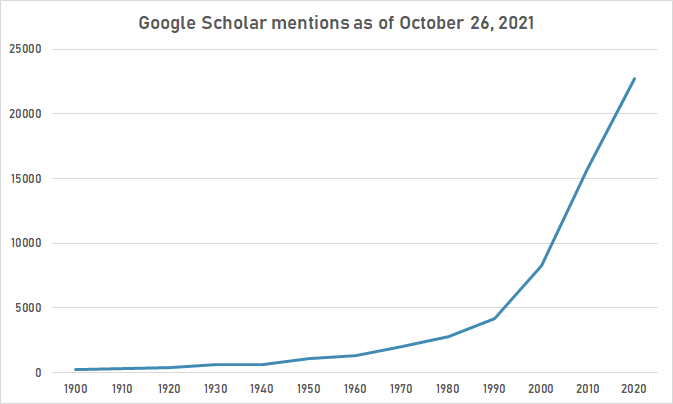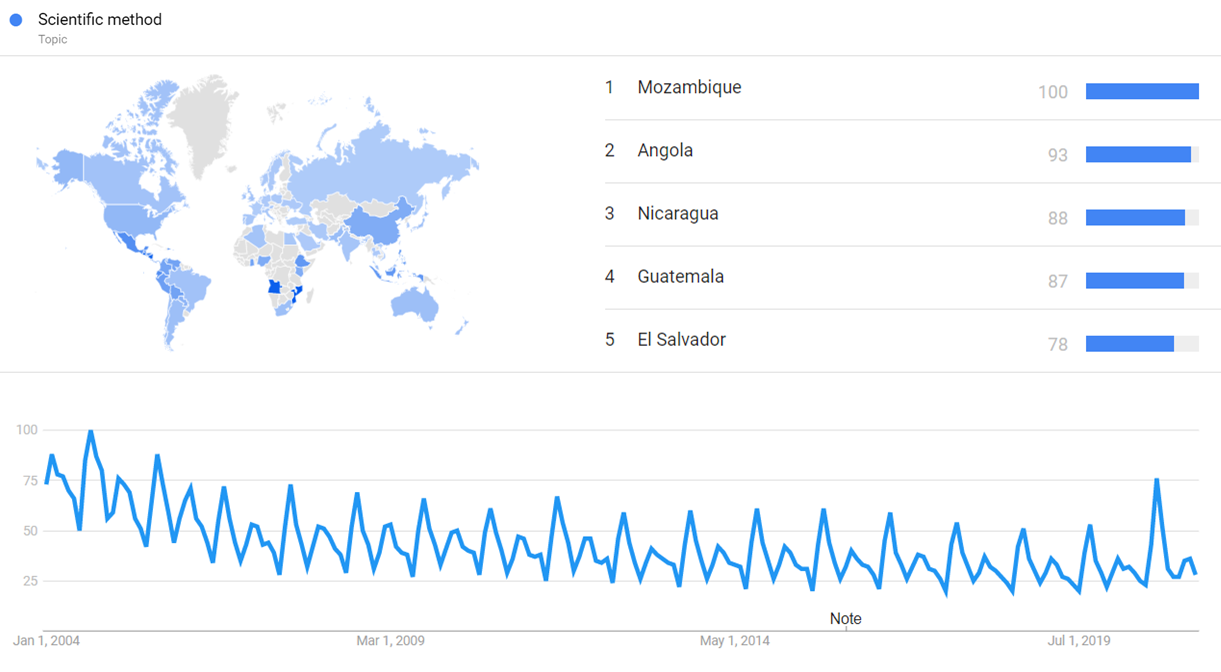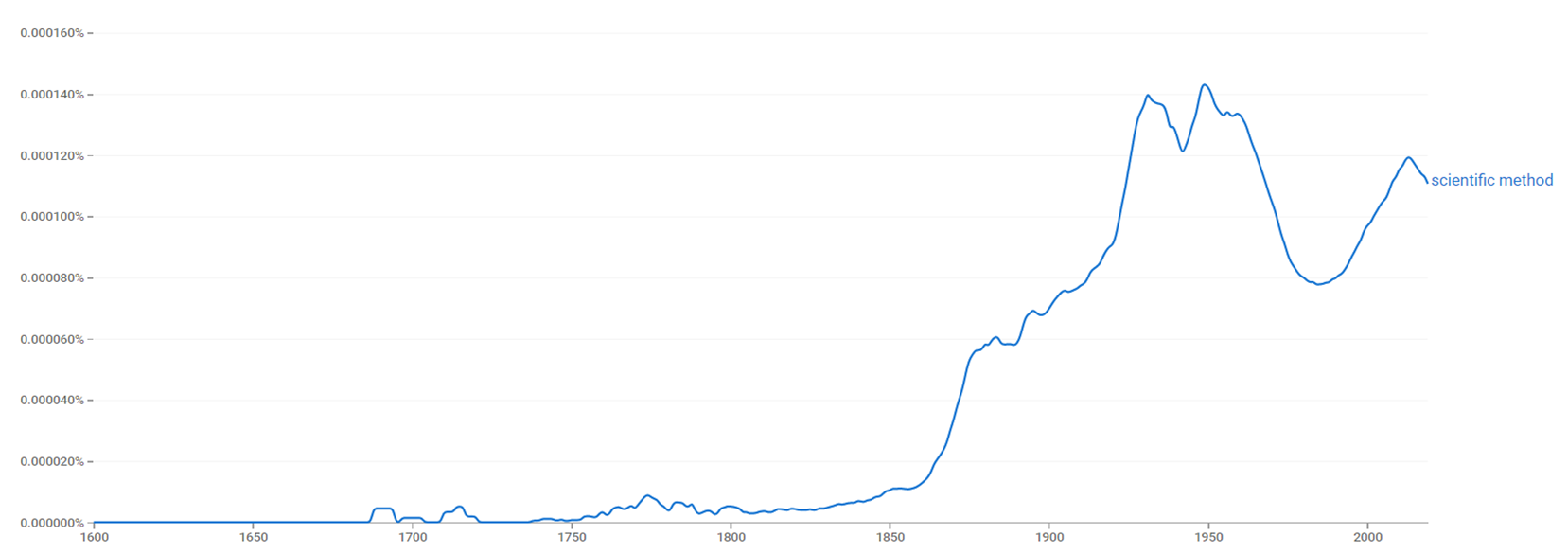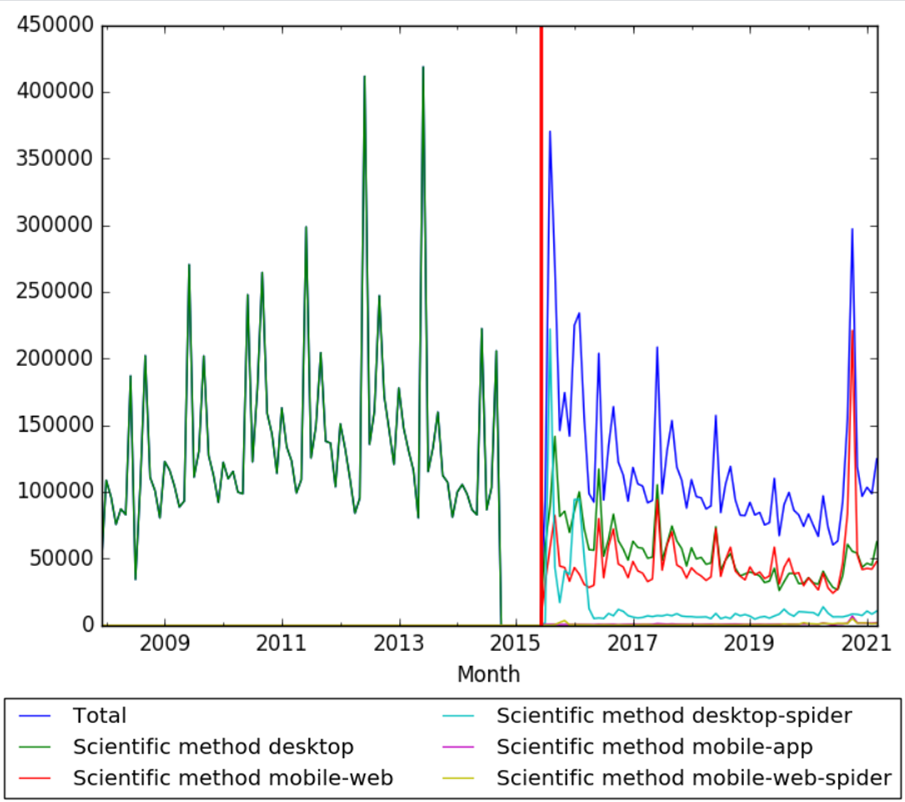Timeline of the scientific method
This is a timeline of the scientific method.
Big picture
| Time period | Development summary | More details |
|---|
Full timeline
| Date | Details |
|---|---|
| c. 1600 BC | The Edwin Smith Papyrus, an Ancient Egyptian medicine textbook, which applies: examination, diagnosis, treatment and prognosis, to injuries,[1] paralleling rudimentary empirical methodology.[2] |
| c. 624 - 548 | Thales raised the study of nature from the realm of the mythical to the level of empirical study.[3] |
| c. 610 - 547 | Anaximander extends the idea of "law" to the physical world and uses maps and models.[3] |
| c. 400 BC | In China, Mozi and the School of Names advocate using one's senses to observe the world, and develop the "three-prong method" for testing the truth or falsehood of statements. |
| c. 400 BC | Democritus advocates inductive reasoning through a process of examining the causes of sensory perceptions and drawing conclusions about the outside world. |
| c. 400 BC | Plato first provides a detailed definitions for idea, matter, form and appearance as abstract concepts. |
| c. 320 BC | First comprehensive documents categorising and subdividing knowledge, dividing knowledge into different areas by Aristotle,(physics, poetry, zoology, logic, rhetoric, politics, and biology). Aristotle's Posterior Analytics defends the ideal of science as necessary demonstration from axioms known with certainty. Aristotle believes that the world is real and that we can learn the truth by experience.[4] Latin:experimentum |
| c. 341-270 | Epicurus scientific method with multiple variables.[4] |
| c. 300 BC | Euclid's Elements expound geometry as a system of theorems following logically from axioms known with certainty. |
| c. 240 BC | Eratosthenes best known for being the first person to calculate the History of geodesy#Hellenic world, which he did by applying a measuring system using Stadion (unit), which was a standard unit of measure during that time period. His calculation was remarkably accurate. |
| c. 200 BC | First Library cataloged library (at Alexandria) |
| c. 150 BC | Book of Daniel describes a clinical trial proposed by Daniel in which he and his three companions eat vegetables and water for 10 days rather than the royal food and wine. |
| c. 90-168 | Claudius Ptolemy[5] |
| c. 721-873 | Science in medieval Islam used experiment and Quantification (science) to distinguish between competing scientific theories, set within a generically empirical orientation, as can be seen in the works of Jābir ibn Hayyān (721–815)[6] and Al-Kindi (801–873)[7] as early examples. |
| 1021 | Ibn al-Haytham introduces the experimental method and combines observations, experiments and rational arguments in his Book of Optics. |
| c. 1025 | Abū Rayhān al-Bīrūnī, develops experimental methods for mineralogy and mechanics, and conducts elaborate experiments related to Islamic astronomy phenomena. |
| 1027 | In The Book of Healing, Avicenna criticizes the Aristotelianism method of inductive reasoning, arguing that "it does not lead to the absolute, universal, and certain premises that it purports to provide", and in its place, develops Observational study and experimentation as a means for scientific inquiry. |
| 1220–1235 | Robert Grosseteste, an English scholastic philosopher, theologian and the bishop of Lincoln, published his Aristotelian commentaries, which laid out the framework for the proper methods of science.[8] |
| 1265 | Roger Bacon, an English monk, inspired by the writings of Grosseteste, described a scientific method, which he based on a repeating cycle of observation, hypothesis, experimentation, and the need for independent Verification and validation. He recorded the manner in which he conducted his experiments in precise detail so that others could reproduce and independently test his results.[9] |
| 1327 | Ockham's razor clearly formulated (by William of Ockham) which states that among competing hypotheses, the one with the fewest assumptions should be selected. |
| 1403 | Yongle Encyclopedia, the first collaborative encyclopedia |
| 1581 | Francisco Sanches uses classical skeptical arguments to show that science, in the Aristotelian sense of giving necessary reasons or causes for the behavior of nature, cannot be attained. |
| 1581 | Tycho Brahe builds large scale research facility, Stjerneborg dedicated to obtaining high precision measurements of the planets. |
| 1595 | Microscope invented in the Netherlands |
| 1600 | First dedicated laboratory |
| 1608 | History of the telescope invented in the Netherlands |
| 1620 | 'Novum Organum published, (Francis Bacon) |
| 1637 | First Discourse on the Method (René Descartes) |
| 1638 | Galileo's Two New Sciences published, containing two thought experiments, namely Galileo's Leaning Tower of Pisa experiment and Galileo's ship, which are intended to disprove existing physical theories by showing that they have contradictory consequences. |
| 1650 | Society of experts (the Royal Society) |
| 1650 | Experimentation evidence established as the arbiter of truth (the Royal Society) |
| 1665 | Repeatability established (Robert Boyle) |
| 1665 | Scientific journal established |
| 1675 | Peer review begun |
| 1687 | Hypothesis/prediction (Isaac Newton) |
| 1739 | David Hume's Treatise of Human Nature argues that the problem of induction is unsolvable. |
| 1753 | First description of a Experimental control using identical populations with only one variable: James Lind's research into Scurvy among sailors.[10] |
| 1763 | Reverend Thomas Bayes published An Essay towards solving a Problem in the Doctrine of Chances laying the basis for Bayesian inference, a method of inference used to update the probability estimate for a hypothesis as additional evidence is acquired. |
| 1812 | The formulation by Hans Christian Ørsted of the Latin-German mixed term Gedankenexperiment (lit. experiment conducted in the thoughts, or thought experiment). Although the method had been in use by philosophers since antiquity. |
| 1815 | An optimal design for polynomial regression is published by Joseph Diaz Gergonne. |
| 1833 | William Whewell invents the term scientist. They had previously been known as natural philosophers or men of science. |
| 1840 | William Whewell in Philosophy of the Inductive Sciences coins the term "consilience" the principle that evidence from independent, unrelated sources can "converge" to strong conclusions. |
| 1877–1878 | Charles Sanders Peirce publishes "Illustrations of the Logic of Science", popularizing his trichotomy of Abductive reasoning, Deductive reasoning and Inductive reasoning. Peirce explains randomization as a basis for statistical inference. |
| 1885 | Charles Sanders Peirce with Joseph Jastrow first describes Blind experiment, randomized experiments, which become established in psychology.[11] |
| 1897 | Thomas Chrowder Chamberlin proposes the use of multiple hypotheses to assist in the design of experiments. |
| 1905 | Albert Einstein proposes the Theory of Relativity |
| 1926 | Completely Randomized Design popularized and analyzed by Ronald Fisher (following Charles Sanders Peirce) |
| 1934 | Falsifiability as a criterion for evaluating new hypotheses is popularized by Karl Popper's The Logic of Scientific Discovery (following Charles Sanders Peirce) |
| 1937 | Controlled Placebo effect trial |
| 1946 | First computer simulation |
| 1950 | Double blind experiment |
| 1962 | Meta study of scientific method (Thomas Kuhn's The Structure of Scientific Revolutions) |
| 1964 | Strong inference proposed by John R. Platt[12] |
| 2009 | Adam (robot) - First working prototype of a "robot scientist" able to perform independent experiments to test hypotheses and interpret findings without human guidance. |
| 2012 | Constructor theory, a proposal for a new mode of explanation in fundamental physics, was first sketched out by David Deutsch. |
Numerical and visual data
Google Scholar
The following table summarizes per-year mentions on Google Scholar as of October 26, 2021.
| Year | "scientific method" |
|---|---|
| 1900 | 219 |
| 1910 | 323 |
| 1920 | 422 |
| 1930 | 612 |
| 1940 | 660 |
| 1950 | 1,050 |
| 1960 | 1,320 |
| 1970 | 2,040 |
| 1980 | 2,820 |
| 1990 | 4,150 |
| 2000 | 8,280 |
| 2010 | 15,800 |
| 2020 | 22,700 |

Google Trends
The chart below shows Google Trends data for Scientific method (Topic), from January 2004 to April 2021, when the screenshot was taken. Interest is also ranked by country and displayed on world map.[13]

Google Ngram Viewer
The chart below shows Google Ngram Viewer data for Scientific method, from 1600 to 2019.[14]

Wikipedia Views
The chart below shows pageviews of the English Wikipedia article Scientific method, on desktop from December 2007, and on mobile-web, desktop-spider, mobile-web-spider and mobile app, from July 2015; to March 2021. A data gap observed from October 2014 to June 2015 is the result of Wikipedia Views failure to retrieve data.[15]

See also
Meta information on the timeline
Acknowledgement
User:Mati Roy imported and formatted the Wikipedia page timeline of the scientific method on July 23rd 2019. You can see the live stream of the work here: [1], [2].
Update strategy
User:Mati Roy: I couldn't figure out how to draw lines around some big picture periods of history with regards to the scientific method as it seems to have developed organically with many small improvements. I used this Google Sheet to format the timeline.
Please put feedback/suggestion/discussion in the Discussion page and tag relevant user(s).
References
- ↑ Edwin Smith papyrus, Encyclopædia Britannica
- ↑ Lloyd, G. E. R. "The development of empirical research", in his Magic, Reason and Experience: Studies in the Origin and Development of Greek Science.
- ↑ 3.0 3.1 Magill, Frank N. (2003-12-16). The Ancient World: Dictionary of World Biography. Routledge. ISBN 9781135457396. Retrieved 9 March 2015.
- ↑ 4.0 4.1 Gauch, Hugh G. (2003). Scientific Method in Practice. Cambridge University Press. ISBN 9780521017084. Retrieved 17 February 2015.
- ↑ Barker, Andrew (2000). Scientific Method in Ptolemy's Harmonics. Cambridge University Press. ISBN 9780521553728. Retrieved 17 February 2015.
- ↑ Holmyard, E. J. (1931), Makers of Chemistry, Oxford: Clarendon Press, p. 56
- ↑ Plinio Prioreschi, "Al-Kindi, A Precursor Of The Scientific Revolution", Journal of the International Society for the History of Islamic Medicine, 2002 (2): 17–19 [17].
- ↑ Ireland, Maynooth James McEvoy Dean of the Faculty of Philosophy National University of (2000-08-31). Robert Grosseteste. Oxford University Press. ISBN 9780195354171. Retrieved 9 March 2015.
- ↑ Clegg, Brian (2013-08-29). Roger Bacon: The First Scientist. Little, Brown Book Group. ISBN 9781472112125. Retrieved 17 February 2015.
- ↑ James Lind's A Treatise of the Scurvy
- ↑ Hacking, Ian (September 1988). "Telepathy: Origins of Randomization in Experimental Design". Isis (journal). 79 (3: A Special Issue on Artifact and Experiment): 427–451. doi:10.1086/354775. JSTOR 234674. MR 1013489.Charles Sanders Peirce and Joseph Jastrow (1885). "On Small Differences in Sensation". Memoirs of the National Academy of Sciences. 3: 73–83. http://psychclassics.yorku.ca/Peirce/small-diffs.htm Stephen M. Stigler (November 1992). "A Historical View of Statistical Concepts in Psychology and Educational Research". American Journal of Education. 101 (1): 60–70. doi:10.1086/444032. Trudy Dehue (December 1997). "Deception, Efficiency, and Random Groups: Psychology and the Gradual Origination of the Random Group Design". Isis (journal). 88 (4): 653–673. doi:10.1086/383850. PMID 9519574.
- ↑ In Strong inference. Certain systematic methods of scientific thinking may produce much more rapid progress than others (Science, 16 October 1964, Volume 146, Number 3642, Pages 347-353.)
- ↑ "Scientific method". Google Trends. Retrieved 16 April 2021.
- ↑ "scientific method". books.google.com. Retrieved 16 April 2021.
- ↑ "Scientific method". wikipediaviews.org. Retrieved 16 April 2021.